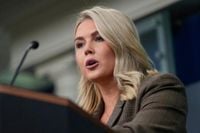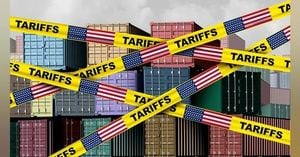On September 22, 2025, a swirl of headlines dominated the American news cycle, but few drew as much attention as the debate over President Donald Trump’s claims regarding record-breaking investment in the United States. The conversation, which began with a brisk White House press briefing by Press Secretary Karoline Leavitt, quickly became a flashpoint for fact-checkers and economists alike, as competing narratives emerged about just how much new money has flowed into the country during Trump’s second term.
Standing at the White House podium, Leavitt was unequivocal in her message. “President Trump has secured nearly $9 trillion in U.S. investment since the start of his second term,” she announced, according to NBC News. Not only did she tout the figure as a monumental achievement, but she also drew a pointed contrast with the previous administration: “That is nearly nine times more than under former President Joe Biden’s administration.” Leavitt went a step further, projecting even greater gains on the horizon. “We expect that number to be upwards of $15 trillion very soon,” she said, underscoring Trump’s “mission to restore America as the manufacturing superpower of the world.”
Yet, just days earlier, President Trump himself had brandished an even loftier figure during his U.K. visit. “We did $17 trillion of investment coming in, a lot of it is because of tariffs,” Trump declared, calling it a “record,” as reported by NBC News. He drew a direct comparison to Biden’s last year in office, claiming, “They did $250 billion. They didn’t do $1 trillion for the four-year period.” For Trump, the surge in investment was proof positive of his administration’s economic prowess: “It’s an economic superstar.” He predicted that the number would continue to grow “significantly higher.”
Trump’s rhetoric wasn’t confined to a single event. Earlier in September, he repeated similar claims, telling reporters, “We’ve taken in, almost $17 trillion of investment is coming in. Most of it is coming because of tariffs,” while the White House pressed the Supreme Court to uphold his tariff policies. He added, “Somebody wanted to be politically correct, I actually think it’s un-politically correct. I think politically correct is to approve it because there’s nothing so popular as what’s happened to our country.”
But as the numbers were tossed back and forth, questions about their accuracy and origins began to surface. NBC News reported that, according to the White House’s own website, the total tally of U.S. and foreign investments since Trump took office stands at $8.8 trillion. This figure is less than Trump’s $17 trillion claim and even slightly below Leavitt’s $9 trillion assertion. Further scrutiny by CBS News revealed that some of the investments credited to Trump’s administration were, in fact, announced prior to his presidency. For instance, the administration claimed $1.5 billion from Corning, a materials and technology company, for a solar plant in Michigan. However, a Corning official clarified to CBS News that $900 million of that funding was actually pledged during Biden’s presidency.
The scale of Trump’s claims has prompted skepticism not just from political opponents but from economists and industry experts. To put things in perspective, the entire U.S. gross domestic product—the broadest measure of the nation’s economy—was a little over $30 trillion as of late August 2025. Trump’s assertion that $17 trillion in new investment arrived in just eight months would mean more than half of the entire annual economic output of the United States had been matched by fresh capital—an extraordinary, and to many, implausible, feat.
For context, China’s entire GDP in 2024 was just over $18.7 trillion, according to World Bank data. Trump’s claim that the U.S. attracted nearly that amount in investment in less than a year raised eyebrows. As NBC News noted, the numbers being cited by the administration are not only historically unprecedented but also out of step with established economic indicators.
Meanwhile, the White House has continued to stand by its broader narrative of economic revival, emphasizing the role of tariffs and industrial policy in attracting foreign capital. “Most of it is coming because of tariffs,” Trump insisted, a point echoed by Leavitt in her briefing. The administration has argued that its policies have not only protected American industries but also made the U.S. a magnet for global investment.
Yet, the numbers game has left some observers wondering about the metrics being used. Investment figures can be notoriously tricky to pin down, as they may include not only new capital expenditures but also reinvestments, mergers, and acquisitions, or even announced projects that have yet to materialize. The White House’s website, for instance, features a running tally under the banner of “The Trump Effect,” but as CBS News pointed out, some of these projects predate Trump’s time in office.
All this has unfolded against a backdrop of other major news stories. On the same day as Leavitt’s press briefing, NBC News also highlighted NASA’s unveiling of a new class of astronaut candidates, Nvidia’s plan to invest up to $100 billion in OpenAI, and disruptions across Italy caused by Gaza protests. The news cycle was as varied as it was fast-moving, but the debate over investment numbers held a unique place at the intersection of politics and economics.
For the American public, the back-and-forth over trillions of dollars may feel dizzying, if not outright confusing. But the stakes are high: investment figures are not just abstract numbers—they’re a barometer of economic health, a measure of confidence in American policies, and a talking point in the ongoing battle for political legitimacy.
As the administration continues to tout its economic achievements and critics demand greater transparency, one thing is clear: the debate over the true scale of U.S. investment under President Trump is far from settled. With both sides digging in, the numbers themselves have become a battleground—one where facts, perception, and politics collide in real time.
Amid the swirl of statistics and claims, Americans are left to weigh the evidence and decide for themselves where the truth lies. The investment debate, it seems, is just getting started.




